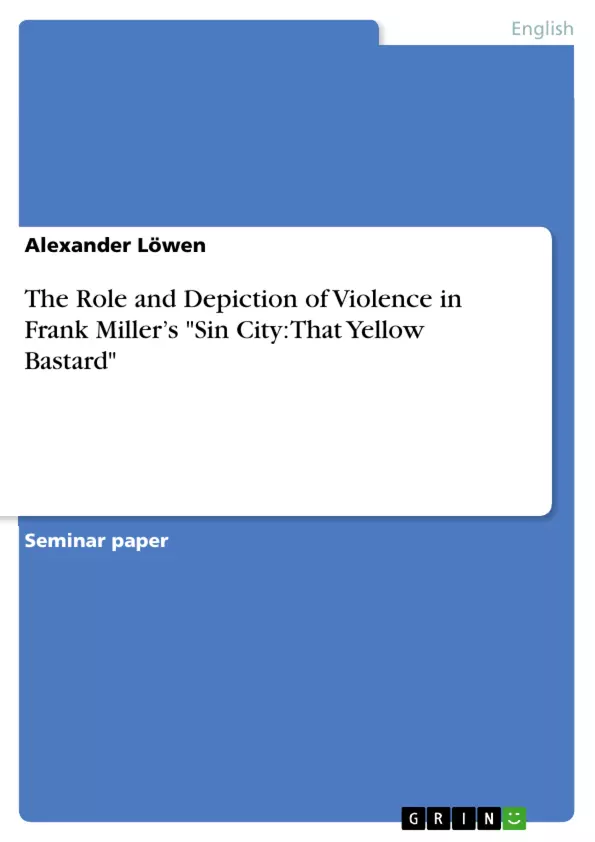Sin City. The graphic novels as well as the film adaptations are well known for their harsh aesthetics, explicit images and ruthless depiction of sex & violence. But violence in Sin City is more than a superficial effect. It is a narrative and significant device. This term paper explores in detail the role and depiction of violence in Frank Miller's Sin City: That Yellow Bastard.
(Note: This work is helpful for both, people who want to learn about the graphic novels as well as for those who are interested in Rodriguez' movies)
Frank Miller’s critically acclaimed comic book series Sin City clearly pushes the borders of the sayable and displayable. The website for popculture complex.com features Sin City in its “The 40 Most Violent Comics Ever” article. According to the
Parents Guide To Movies2, the film adaption of Sin City matches all criteria of mature content to an extraordinary extent: sex and nudity, violence and gore, profanity, alcohol
and smoking as well as intense fighting scenes. And so does the comic itself. Nevertheless, Frank Miller was awarded several times with the Eisner Award - the most important American award for comic artists.
This paper will deal with the 4th volume of the Sin City-series: That Yellow Bastard. I chose this volume, as I consider it representative of the whole series. In accordance, the Sin City film adaption, directed by Frank Miller and Robert Rodriguez,
featured many scenes of That Yellow Bastard volume. The graphic novel comes up with a unique noir, black-and-white style, roughness and an unadorned depiction of the
characters’ dirty traits - his tendency towards violence.
Inhaltsverzeichnis (Table of Contents)
- I. Introduction
- II. Crime, Violence and Aesthetics
- 1. General Style
- 2. Aesthetics and Meaning of Violence in Sin City: That Yellow Bastard
- a.) Physical Violence
- b.) Violence with Weapons
- c.) Sexual Violence
- d.) Verbal Violence
- III. Conclusion
Zielsetzung und Themenschwerpunkte (Objectives and Key Themes)
This paper analyzes the depiction of violence and its role within the Sin City narrative, focusing on the 4th volume, "That Yellow Bastard," as representative of the whole series. It aims to explore the aesthetics and meaning of violence in this graphic novel, demonstrating that it is not merely a stylistic or narrative device but serves as a foundation for the storytelling.
- The portrayal of violence as a defining characteristic of Sin City's crime
- The relationship between violence and the characters' motivations and actions
- The use of violence as a serious medium of storytelling
- The contrast between violence in Sin City and other graphic narratives
- The exploration of Walter Benjamin's concept of latent violence in the legal system and its application to the Sin City narrative
Zusammenfassung der Kapitel (Chapter Summaries)
The introduction examines the graphic novel's depiction of violence and its significance within the context of the Sin City series and its film adaptation. It establishes the central theme of violence and its role in shaping the narrative.
Chapter II explores the aesthetics and meaning of violence in "That Yellow Bastard," analyzing its different forms - physical, weaponized, sexual, and verbal - and examining how they contribute to the story's overall message. The chapter connects the use of violence to the characters' motivations, highlighting their reliance on it to navigate their lives.
Schlüsselwörter (Keywords)
The primary focus of this paper is on the representation of violence and its function as a storytelling device in Frank Miller's Sin City: That Yellow Bastard. Key terms include: graphic novel, noir, black-and-white style, violence, aesthetics, meaning, stylistic device, narrative, crime, motivation, Walter Benjamin, latent violence.
- Quote paper
- Alexander Löwen (Author), 2014, The Role and Depiction of Violence in Frank Miller’s "Sin City: That Yellow Bastard", Munich, GRIN Verlag, https://www.grin.com/document/286130



